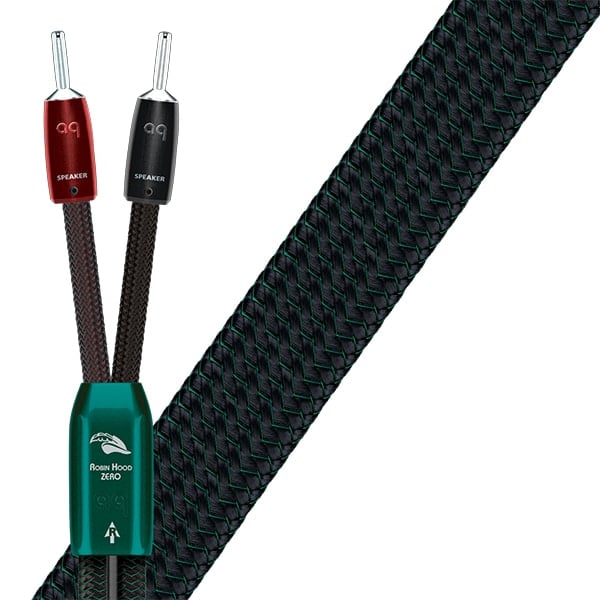Description
AudioQuest Robin Hood Zero factory terminated speaker cable
Building on a solid base of tried and true AudioQuest technologies, the design team of Garth Powell and Bill Low specifically focused on addressing one of the most vexing issues plaguing speaker cable design: the mismatch between the amplifier’s source impedance and the speaker’s load impedance. By eliminating the speaker cable’s characteristic impedance (ZERO Technology), current compression and distortion of the signal/current transient are significantly reduced. The result is dynamic contrast, transient response, and bass slam that are rendered seemingly without effort, because the cable is not electrically impeding the music.
Like the larger-gauge cables of the Mythical Creatures Series, William Tell and Robin Hood can be used in one of two ways: either employing the ZERO model for full-range, or by using the ZERO model in combination with a dedicated bass cable, as a fully optimized BiWire Combination cable. Like their larger siblings, William Tell and Robin Hood also feature AudioQuest’s patented common-mode noise-rejection technology. Along with the Mythical Creatures, these latest AudioQuest speaker cables significantly outperform previous technology at controlling and draining radio-frequency noise.
Solid perfect-surface silver (PSS) & solid perfect-surface copper+ (PSC+) conductors
Solid conductors prevent electrical strand-to-strand interaction, major sources of distortion. Surface quality is critical because a conductor can be considered as a rail-guide for both the fields within a conductor, and for the magnetic fields that extend outside the conductor. The astonishingly smooth and pure perfect-surface copper+ eliminates harshness and greatly increases clarity compared to OFHC, OCC, 8N, and other premium coppers. Extremely high-purity perfect-surface silver further minimizes distortion caused by grain boundaries, which exist within any metal conductor.
ZERO: No characteristic impedance for uncompressed current transfer
The integrity of any audio transient (instantaneous peak-to-peak voltage swing and current) delivered from a power amplifier to a loudspeaker has always been compromised. Whether the amplifier is valve or transistor, regardless of class of operation, the amplifier’s source impedance and loudspeaker’s load impedance are never critically matched. The speaker cable’s characteristic impedance is yet another culprit in a highly compromised non-linear electrical circuit. By eliminating a speaker cable’s characteristic impedance, AQ’s ZERO Technology is an unprecedented step towards reducing that damage. The result is greater dynamic contrast, better audio transient response, and bass slam that are rendered seemingly without effort because the cable is not electrically restricting the music.
Carbon-based linearized noise-dissipation system (NDS)
Today’s environment is saturated with radio-frequency noise that is extremely difficult to filter or reject. The frequencies of this noise from satellites, cellular towers, and Bluetooth, etc., are so extremely narrow that a conventional shield, or a series or shunt filter, is wholly inadequate. AQ’s comprehensive linearized noise-dissipation system combines multiple shields and a carbon-based linearized resistive network that turns most of this noise into heat. The system is equally effective across an extremely wide bandwidth rather than at selected frequencies only, as is more common. The remaining bad energy is effectively drained away from the sensitive amplifier circuits via directionally controlled signal and shield conductors.
Directionality
All drawn metal strands or conductors have a non-symmetrical, and therefore directional, grain structure. AudioQuest controls the resulting RF impedance variation so that noise is drained away from where it will cause distortion. The correct direction is determined by listening to every batch of metal conductors used in every AudioQuest audio cable. When applicable, arrows are clearly marked on the connectors to ensure superior sound quality. For most models of AQ cable, the arrows not only indicate the direction that optimizes metal-directionality as part of noise-dissipation, but also indicate non-symmetrical attachment of shield and GND in order to optimize full-system performance.
Dielectric-bias system with carbon-level radio-frequency trap (DBS)
All insulation is also a dielectric whose electrical properties affect the integrity of the signal. When the insulation is unbiased, dielectric involvement (absorption and non-linear release of energy back into the signal flow) causes different amounts of time delay (phase shift) for different frequencies and energy levels. AudioQuest’s multi-patented DBS creates a strong, stable electrostatic field that saturates and polarizes (organizes) the molecules of the insulation, minimizing the nonlinear time delays, resulting in clearer sound emerging from a “blacker” background. The inclusion of an RF Trap (a technology developed for AudioQuest’s Niagara Series of power products) in the DBS battery pack further reduces radio-frequency noise. The DBS battery packs will last for many years, and a test button with an LED allows for an occasional battery check.
KEY FEATURES:
• ZERO technology for uncompressed current transfer and enhanced dynamic contrast
• Solid perfect-surface silver (PSS) and perfect-surface copper+ (PSC+) conductors for minimized distortion and improved clarity
• Carbon-based linearized noise-dissipation system for wide bandwidth noise reduction and improved sound quality









